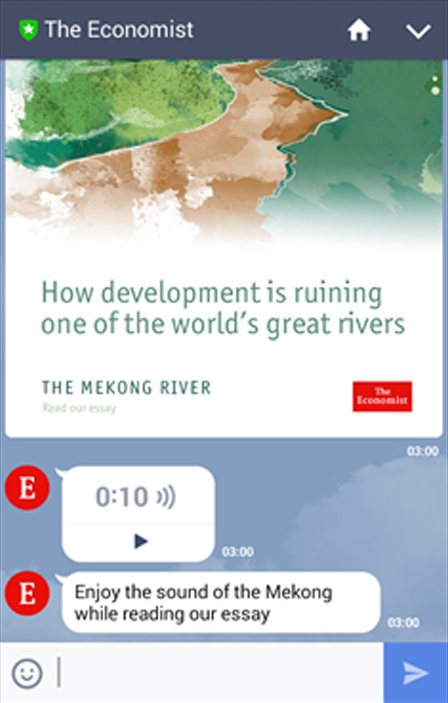
At the end of January, The Economist started distributing its content on Line, joining the ranks of news organisations such as The Wall Street Journal, BBC and Mashable.
Now, six weeks after The Economist became active on Line, it has almost reached 100,000 subscribers (98,738 at the time of writing), after publishing 249 posts.
So why has the outlet decided to tap into Line's audience and experiment with news on this messaging platform, rather than start using other apps such as WhatsApp, Telegram or Viber for example?
The Japanese messaging app is still a long way behind WhatsApp, but it has grown in popularity in the last year, particularly in the Asian market.
The number of total monthly active users on Line reached 215 million in December 2015, according to figures released by the company on January 28.
Denise Law, community editor at The Economist, said the goal is to access markets where the title doesn't necessarily have a big presence, such as Myanmar, Cambodia, South Korea, Hong Kong and Saudi Arabia.
"We want to let people know that we don't write just about economics," she told Journalism.co.uk.
"Our strategy for Line is quite similar to what we do on platforms like Pinterest, Tumblr and LinkedIn, as opposed to the strategy we have for Facebook and Twitter, where we put out everything from the print issue."
Social cards work better than simple text posts with links
The Economist's approach is "the world explained in bite-sized messages", Law said, publishing four posts per day on average and featuring more "timeless" content.
The outlet created bespoke templates for the different types of content it distributes on Line. These range from a picture of the magazine's cover to charts, videos, and image galleries.

On This Day, a format The Economist uses to highlight significant historical events on Facebook, is also featured on the messaging app as a card containing an image and a quote.
The advantage Line offers over other chat apps is its homepage feature, where every piece of content published can also be found at a later time.
This means people can scroll through it as they do with their Facebook news feed – so it is important to give them an experience of having learned something without clicking on any of the accompanying links to a post, explained Law.
"If you're somebody who is in Cambodia or Myanmar, this might be when and how you're experiencing The Economist for the first time.
"And we've noticed people are more likely to subscribe after they've sampled a breadth of content, not just our economics coverage."
Images and video are always published with accompanying text, and a map or a chart would also feature alongside an interesting fact or bullet points explaining the importance of the topic.
The Economist is not using Line as a way to get new subscribers for the magazine, said Law, as the focus at this time is on increasing its reach.
Push alerts are the main drivers of traffic to the website
The team works with the premise that the click through rate on posts published on the Line homepage is going to be low. But this is where the ability to send push alerts becomes an advantage.
"We do between two and four push alerts each week, aiming for five a week, and we tend to choose things that have an Asian focus or that are quite global.
"The content that you post with links on the homepage is less likely to drive traffic than push alerts are, so we always push articles that are in front of the paywall to get people to delve deeper into that coverage."
For example, The Economist recently experimented with audio as a push alert, to highlight its comprehensive essay covering how new constructions on the river Mekong in Southeast Asia are affecting the waterways and the region.
The 10-second audio clip, a recording of the river flowing, was meant to capture people's attention before they started reading the five-part essay on the topic – 32 per cent of people who clicked on the alert and went back to the website were from Cambodia.

Screenshot courtesy of Denise Law
Other formats that seem to do well with The Economist's readers on Line are quote cards and photos of the day with the news peg explained in a few sentences. The click through rates on the messaging platform are on average two per cent higher than those on Facebook and Twitter, said Law.
"We look at it as a brand building initiative. So our metrics for success on Line are growing our following, driving a decent amount of traffic from push alerts and building up engagement on the homepage," she said.
Free daily newsletter
If you like our news and feature articles, you can sign up to receive our free daily (Mon-Fri) email newsletter (mobile friendly).
Related articles
- The Economist launches podcast-only news subscription
- DCMS-backed media literacy programme is supporting vulnerable internet users
- WSJ, Economist and FT all now have women editors – what does it mean for business?
- Tip: Inside The Economist's Instagram growth strategy
- What does the future hold for newsletters?









